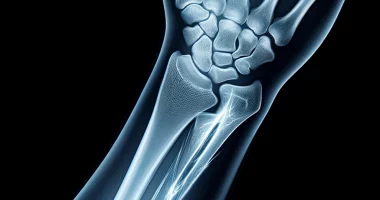Elbow instability
General information
Elbow instability is a pathologic condition usually caused by damage to the capsular ligamentous apparatus. Damage to the capsular ligamentous apparatus does not occur by itself. It is a traumatic pathology and, therefore, most often accompanies intra-articular injuries (fractures, dislocations, etc.) and is also a consequence of multiple microtraumas to the capsule and ligaments of the elbow joint (most often in professional sports).
Epidemiology
Elbow sprains are a relatively common musculoskeletal injury. They can affect people of all ages, especially those who are active in sports and those who work physically demanding jobs. This injury can cause significant pain and impairment of hand function, resulting in significant limitations in daily life or in performing certain activities.
Statistically, elbow sprains are one of the most common dislocations in the body. They account for about 10-25% of all dislocations. In many cases, elbow dislocations occur in conjunction with other injuries, such as broken bones or torn ligaments. The frequency of elbow dislocations depends on a person’s age, gender, and activity level.
Due to the potentially serious consequences of elbow dislocation, it is important to recognize this injury early, diagnose it, and begin appropriate treatment to minimize potential complications and ensure optimal recovery.
Types of instability
- Posterolateral rotation. Develops when the head of the radius is displaced during external rotation of the forearm.
- Valgus (medial, internal). Characterized by excessive lateral mobility of the forearm to the outside of the humerus.
- Varus (lateral, external). It is characterized by excessive lateral mobility of the forearm to the inside of the humerus.
Symptoms of elbow instability
Elbow joint instability produces a variety of complaints and symptoms that can vary depending on the cause and severity of the insufficiency. Patient complaints are often scattered, ranging from pain, clicking, and blocking to a feeling that the joint is “falling out.” Most often, instability manifests when getting up from a chair with the help of the upper limbs. In extreme cases, painful, recurrent partial dislocations may occur. The degree of chronic instability is directly proportional to the severity of the original ligament damage or the intensity of overexertion during sports at altitude.
The most common complaints are as follows:
- Pain. The pain may be dull, stabbing, or throbbing, increasing with elbow movement.
- Limitation of mobility. Elbow insufficiency can result in limited mobility in the elbow joint. Patients may have difficulty bending and extending the elbow.
- Instability. The elbow joint can become unstable, which can lead to a feeling of insecurity or “slipping.” It can affect your ability to use your arm normally and perform certain activities.
- Joint noises. In elbow disease, there may be grinding, cracking, or rubbing sounds in the joint.
- Loss of strength. Weakening of the muscles around the elbow can lead to a decrease in grip strength and overall arm strength.
- Swelling and inflammation. Inflammation and swelling can occur around the elbow joint, resulting in visible swelling and redness.
- Numbness or tingling. In some cases, ulnar insufficiency can cause numbness or tingling in the arm or fingers, especially if the nerve structures in the elbow area are affected.
It is important to note that the symptoms and complaints of elbow impingement can vary depending on the underlying cause. The most common causes are injury, osteoarthritis, nerve compression, inflammation, or overuse. A medical professional’s accurate diagnosis is necessary to determine the cause of insufficiency and begin appropriate treatment. The feeling of instability also increases in proportion to the degree of the disease.
Diagnosis
The diagnosis of ulnar insufficiency usually requires a thorough clinical examination and the use of imaging techniques to confirm and assess the degree of insufficiency.
The physician first collects a detailed history to obtain information about symptoms, the onset of complaints, injuries, and past illnesses. Then, a physical examination of the elbow is performed to assess for swelling, deformity, restriction of motion, pain, and instability.
Imaging techniques help diagnose the condition in more detail. X-rays can reveal bone irregularities, misaligned joints, or signs of elbow osteoarthritis. MRIs provide detailed images of soft tissue structures such as ligaments, tendons, cartilage, and nerves. It can help evaluate ligament tears, compressed nerves, or other injuries.
After diagnosing elbow insufficiency, your doctor can discuss the findings with you and recommend an appropriate treatment strategy. Accurate diagnosis is important to identify the cause of the insufficiency and initiate appropriate conservative or surgical treatment.
Treatment of elbow joint instability
The choice of treatment method directly depends on the degree of pathology. At the initial stage of the disease development, with complex conservative treatment, it is possible to correct the pathology completely. At this stage, it is shown:
- If possible, remove stresses that provoke instability (for the entire period of treatment as well as for the rehabilitation period);
- Medication – non-steroidal anti-inflammatory drugs (especially in acute trauma);
- Physiotherapy treatment, including electromyostimulation;
- Blocks to the elbow joint;
- Use of orthotics;
- Rehabilitation activities (to return strength to the muscles).
In advanced cases of elbow instability, surgical treatment is indicated. Surgery is generally aimed at restoring the joint’s integrity (in case of injury), removing bone fragments (in case of trauma), eliminating degenerative structures, and stabilizing the joint. The surgery is performed arthroscopically or open, depending on the degree of damage to the joint and, as a result, the expected extent of intervention. The joint is stabilized with special instruments – autografts, anchor fixators, and artificial ligaments.
All these treatment options are available in more than 870 hospitals worldwide (https://doctor.global/results/diseases/elbow-instability). For example, Surgical treatment of elbow instability can be performed in 29 clinics across Turkey for an approximate price of $2.8 K (https://doctor.global/results/asia/turkey/all-cities/all-specializations/procedures/surgical-treatment-of-elbow-instability).
Rehabilitation period
Rehabilitation is a mandatory stage of treatment, without which complete recovery is impossible. An individual comprehensive program is developed, usually consisting of several stages:
- Immobilization of the joint to limit the load
- Special exercises to restore elementary motor activity (gymnastics, stretching)
- Restore muscle strength and tone.


